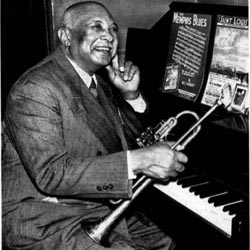
W.C. Handy. Photo courtesy of lastfm.
This edition of Riverwalk Jazz, a radio show titled Milestones of American Jazz Masters, was created to close out 2003, a year chock full of important jazz anniversaries. For starters, there was a lengthy roster of distinguished jazz centenaries to celebrate. Ragtime pianist and composer Eubie Blake, Jazz Age cornet legend Bix Beiderbecke, the first great violinist in jazz Joe Venuti, and the ‘Father of the Blues’ W.C. Handy all celebrated 100th birthdays— or more. This week The Jim Cullum Jazz Band pays tribute to these jazz luminaries, and says goodbye to the fabled alto saxophonist, composer and Riverwalk Jazz guest Benny Carter.
Of all the different types of music that went into making early jazz, the blues are the foundation. W.C. Handy, the first to publish authentic blues for mainstream audiences, was born 130 years ago this year in Florence, Alabama; it was only eight years after the Civil War had ended. Dubbed “The Father of the Blues,” Handy earned his title for his work collecting and transcribing African-American folk blues he heard in the countryside along the Mississippi Delta. The now familiar twelve-bar form Handy standardized from folk tunes was a prime foundation of jazz. Jazz artists from King Oliver to John Coltrane owe Handy a tremendous debt. Regardless of their performing style, they all played twelve-bar blues as Handy had codified the form.
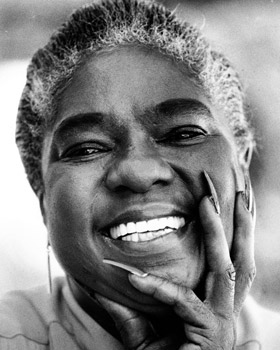
Linda Hopkins. Photo courtesy of LA Times.
In the early 1900s, the city of Memphis, then as now, had a lively club scene on Beale Street. It was there that W.C. Handy first found success as a bandleader and blues songwriter. On this broadcast, blues shouter Linda Hopkins, revered for her one-woman Broadway show Me and Bessie, lends her voice to Handy’s 1916 hit “Beale Street Blues.” By 1917 W.C. Handy was living in New York running the first African-American controlled publishing house, the Pace & Handy Music Company. Honored as an elder statesman of black music in the Harlem Renaissance of the 20s, Handy continued to write new compositions and compile collections of blues and spirituals. Though he was blind, a year before his death in 1954 at the age of 81, Handy gave a magnificent performance of his “St. Louis Blues” on a national TV broadcast of The Toast of the Town with Ed Sullivan.
Ten years after W.C. Handy was born in Alabama, James Hubert Blake was born in Baltimore. ‘Eubie’ (short for Hubert) Blake was an awe-inspiring pianist and a gifted composer. He ran into trouble trying to publish sheet music of his “Charleston Rag” in 1899 because it was so complex. The publisher told him, “Sure, it’s a wonderful tune, but nobody will be able to play it except for Luckey Roberts and you.”
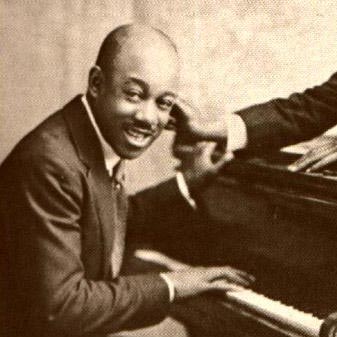
Eubie Blake. Photo courtesy of eubieblake.org.
By 1910 Eubie Blake’s pre-jazz piano style was known as East Coast Ragtime. It represented a transition between the classic rags of Scott Joplin and the “stride” style of piano jazz pioneered by James P. Johnson a few years later. Eubie Blake was on the cutting edge of popular music in America in 1921 for his collaboration with Noble Sissle on the Broadway musical comedy Shuffle Along. The immensely popular show brought authentic jazz rhythms back to the Broadway stage with an all-black cast and crew. Just about every dance step then in vogue was included in the musical— from the Baltimore Buzz to Eubie’s foxtrot “I'm Just Wild About Harry.“ Almost cut from the production in out of town trials, instead “Harry” became a blockbuster hit. Our version, heard on this broadcast, features the enormously talented Dick Hyman on piano with The Jim Cullum Jazz Band.
Throughout the 30s Eubie Blake wrote a long string of hits with lyricists Andy Razaf, Henry Creamer and others. By the early 40s Blake was working as musical director for touring USO shows. He retired in 1946, and then in the 60s at the age of 80 Eubie made a comeback; he successfully revived his career as a recording artist after a 20-year hiatus from the music business. To his surprise, Eubie was a popular talk show guest, making frequent appearances on The Tonight Show with Johnny Carson. Eubie Blake died in 1983 at the age of 100.
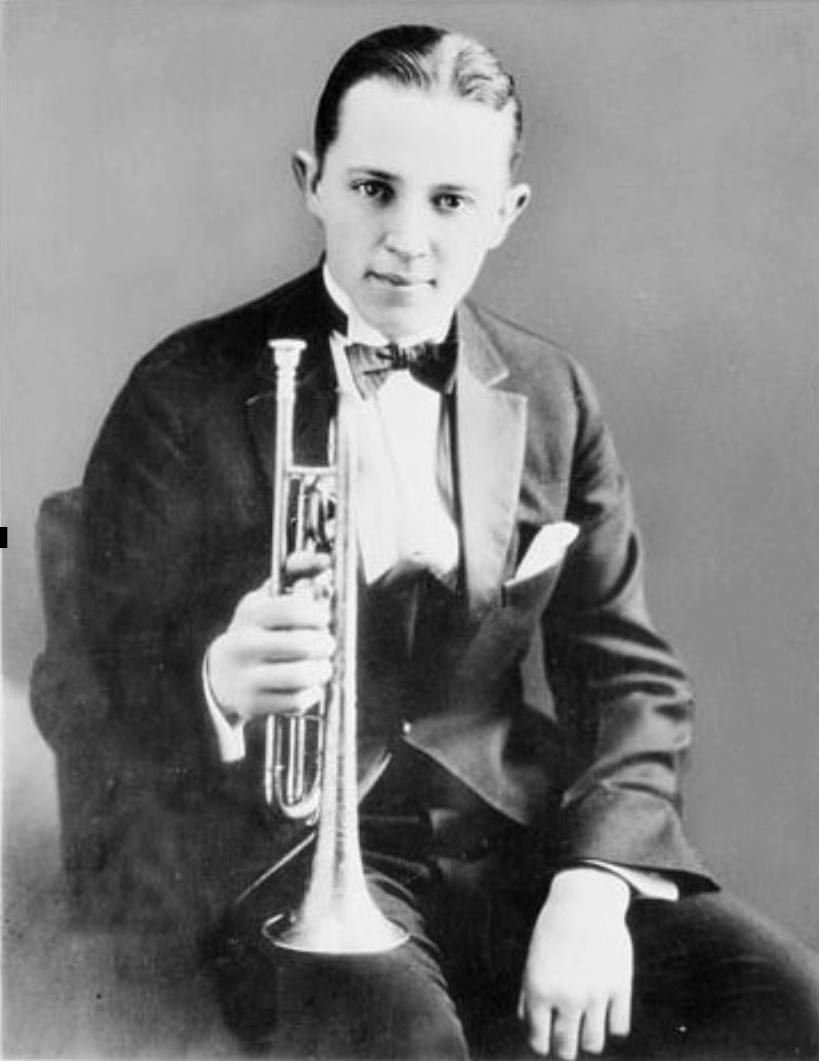
Bix Beiderbecke. Photo in public domain.
2003 marks the 100th birthday of two influential jazz artists who came of age in the Roaring 20s—cornetist Bix Beiderbecke and violinist Joe Venuti. Both belong to the first generation of white jazz players to gain renown in the Jazz Age. Venuti and Beiderbecke came from very different backgrounds—Bix from a middle class family in a sleepy, river town in Iowa and Venuti from an immigrant family in urban Philadelphia. Their common language was hot jazz and they found themselves wowing audiences and working together in the Paul Whiteman Orchestra of the 20s. The many recordings they made together in small hot jazz groups, like Frankie Trumbauer and His Orchestra, are still considered classics today.
Joe Venuti was the first violinist to play truly hot jazz on the violin. Like Bix, Venuti seems to have worked out much of the technique of playing for himself, though it appears he picked up solid classical training along the way. Joe Venuti blazed a trail for Hot Club of France violinist Stéphane Grappelli, who was inspired in his career by Venuti’s hot jazz approach on violin.
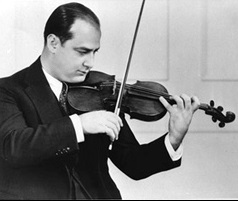
Joe Venuti. Photo courtesy of redhotjazz.
Among Venuti’s tremendous contributions to jazz are a series of recordings he made with his guitarist partner and lifelong friend Eddie Lang. The Venuti and Lang duo created a distinctive New York sound in the late 20s and early 30s. “Beatin' the Dog,“ heard here with Andy Stein on jazz violin and Marty Grosz on acoustic guitar, pays tribute to the 1927 Venuti/Lang recording. Vince Giordano picks up his bass saxophone to join fiddler Andy Stein on another Venuti/Lang original from 1927, “Four String Joe.”
Finally, we remember Benny Carter—whose arrangements helped to define the Swing Era sound of the Big Bands.
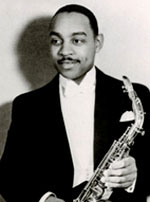
Benny Carter, 1936. Photo courtesy of Rutgers University.
Carter was born in 1907 and died in 2003 at the age of 95. By the time he paid us a visit at the Landing in 1992, Carter had had a long and illustrious career in jazz. He was a composer and respected big band leader and an accomplished player of several instruments. He scored the music for many films and hit TV shows including Rod Serling’s Night Gallery, Ironside and M Squad. In the late 1920s and early 30s, Carter wrote arrangements and played alto sax and trumpet in two key bands of the era: The Fletcher Henderson Orchestra and McKinney’s Cotton Pickers. He went on to lead his own bands in the US and Europe and recorded over a dozen CDs for which he received seven Grammy nominations and two Grammy Awards. Miles Davis said, “Everyone should listen to Benny Carter, he’s a whole musical education.”
Carter was one of a rare breed of wind players able to master both reed and brass instruments, in his case the alto saxophone and the trumpet. He was superb on both. Performing with us at The Landing in San Antonio, Benny Carter said his greatest influence on trumpet was Doc Cheatham. Carter said, “Doc made a trumpet player out of me.” Speaking of musicians who influenced his saxophone playing, Benny Carter made special mention of Frank Trumbauer, who “did not make useless use of a lot of notes.” Benny Carter’s universal respect among jazz musicians earned him the nickname “The King.”
The 130-year span between the birth of W.C. Handy and the passing of Benny Carter in 2003 contains much of the story of jazz itself. The lives of the five men we’ve celebrated here and their music embrace a grand legacy. That’s 130 years of marvelous swinging, stomping and wailing.
Broadcast Playlist Music Notes:
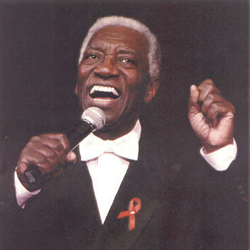
Joe Williams. Photo courtesy xlyrics.de.
“(I’d Give a) Dollar for a Dime“ is a nostalgic and bittersweet tune Eubie Blake wrote with Andy Razaf. Our version is an encore performance by the renowned Count Basie singer Joe Williams, captured live at The Landing in San Antonio.
“Friendless Blues“ is a W. C. Handy blues composed in 1926. For many years, this number was the sign-off theme of Lu Watters Yerba Buena Jazz Band of San Francisco.
“Clarinet Marmalade“ is an Original Dixieland Jazz Band tune from 1917, later adopted by Bix Beiderbecke and the Wolverines in the 1920s.
“The Baltimore” was composed by Jimmy McHugh and recorded by Bix Beiderbecke and Joe Venuti in 1927. Our version features New York players Andy Stein on hot fiddle and bandleader/bass saxophonist Vince Giordano.
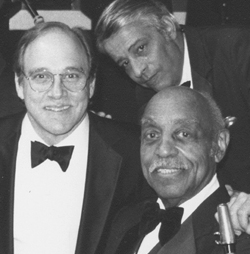
Benny Carter with Jim Cullum and Ed Torres at The Landing, 1992. Photo courtesy of Riverwalk Jazz.
“Four String Joe“ is another Joe Venuti classic. On the performance heard here, Stein re-creates Venuti’s technique of playing all four strings of the violin at the same time.
“When Lights Are Low,“ composed by Benny Carter in 1937, was later recorded by Miles Davis and Sarah Vaughan, among others. For its time, the harmonic underpinning of this tune (known as the “chord changes”) is considered to be quite advanced.
“Blues In My Heart“ is another Carter original, in our version it’s a feature for Benny Carter’s mastery of the alto saxophone; “All That Jazz“ features a charming vocal by Mr. Carter.
Photo credit for Home Page: W.C.Handy. Photo courtesy lastfm.
Text based on Riverwalk Jazz script by Margaret Pick ©2003

